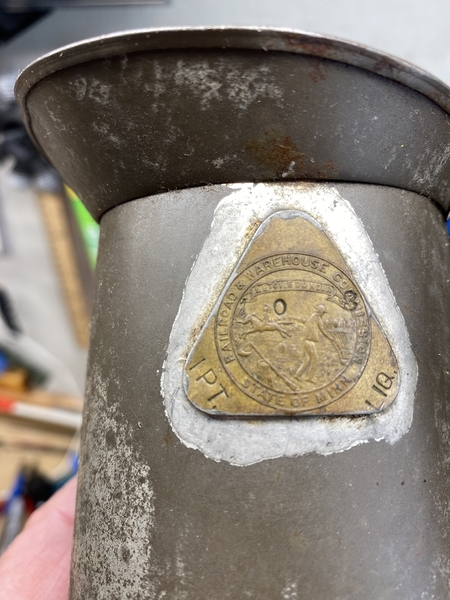Is it cool? Does the nameplate set for certification of measurement? And idea of age? Grandpa worked in the Roundouse up in Proctor, Minnesota back in the day. Found this among the red lanterns. 



Replies sorted oldest to newest
Not sure what it is; other than an extraordinary find. A google search for the company name led me to the Railroad and Warehouse Commission for Minnesota. Let us know what you uncover.
Looks a bit large to only hold a pint. Any internal markings?
Mitch
I think its a pitcher that is not a railroad one but someone glued the railroad emblem on pitcher !
the lanterd look like a antique railroad one !
Alan
@Alan Mancus posted:I think its a pitcher that is not a railroad one but someone glued the railroad emblem on pitcher !
Agreed.
the lanterd look like a antique railroad one !
Just my opinion but, I believe that lantern is more marine oriented, i.e. Great Lakes, what with that VERY wide base. Must admit that I've never seen a railroad lantern like THAT.
Alan
The lantern is not a RR lantern specifically but could have been used in the area. The Number 40 by Dietz was used by highway workers like the yellow flashers we see today. Construction, hazard, accident type situations on roads.
@Miggy posted:
"MIGGY"....I moved this thread because it is a topic about something that is related to REAL TRAINS, not 3-rail traditional toy trains.
My guess is that the the pitcher is the real deal. According to Google, the railroad and warehouse commission was tasked with regulating railroads, safety, quality of goods, and other duties as directed.
I think some official from the era took an ordinary pitcher and turned it into official quasi-government kit by affixing that seal to it. I don't believe it was intended for drinking but rather for checking the quality/quantity of something. I agree that the pitcher holds considerably more than one pint so it was likely used in conjunction with other equipment.
The seal is affixed in such a way as to be visible to a right-handed user. It is brazed on in a manner similar to how the pitcher is constructed. I also see "0" and "3" stamped into the seal. I imagine that the seal was intended like the inventory control bar code tags of today and was affixed to various equipment. The "3" appears to match the size and font of the other imprints. The "0" looks smaller. Also, the "0" and "3" are not stamped in the top corner, where there is space, but rather in the middle. This suggests to me that those characters were added by a different individual at a different time.
The red lantern looks like a grade-crossing gate lantern to me.
Jon ![]()
The lantern is easy:
OP states that the pitcher was found among the red lanterns. I find it very curious that the "1 PT." marking on the pitcher corresponds to the capacity of the red lantern (as given on the website I linked to above). Now I envision the lanterns on the floor and a worker's left hand holding a funnel (missing) and his right hand pouring kerosene into the lanterns from a larger container using the pitcher.
This may have been the original purpose of the pitcher. As train inspectors, the Railroad and Warehouse Commission may have had their own lanterns.
The Commission did shut down years before the lanterns went out of style, so it also possible that some railroader repurposed the pitcher from the defunct commission to fill their own lanterns. I think that this is more likely the case, because it doesn't seem like an ideal pitcher to fill lanterns with. I suspect that this hypothetical railroader also added the "1 PT." mark to remind others about the capacity of the lanterns.
All conjecture, obviously.
I don't think either of those items has anything to do with railroading. Especially the lantern, which, as Edmund Schwartzel pointed out, was for roadwork warnings. You guys who think the red lantern looks anything like a railroad lantern might want to avoid purchasing anything from a railroadiana show, if you don't want to be fleeced.
And whoever soldered the badge on the pitcher did a pretty bad job. Certainly not something a railroad tinsmith would be proud of.
Many thanks all








